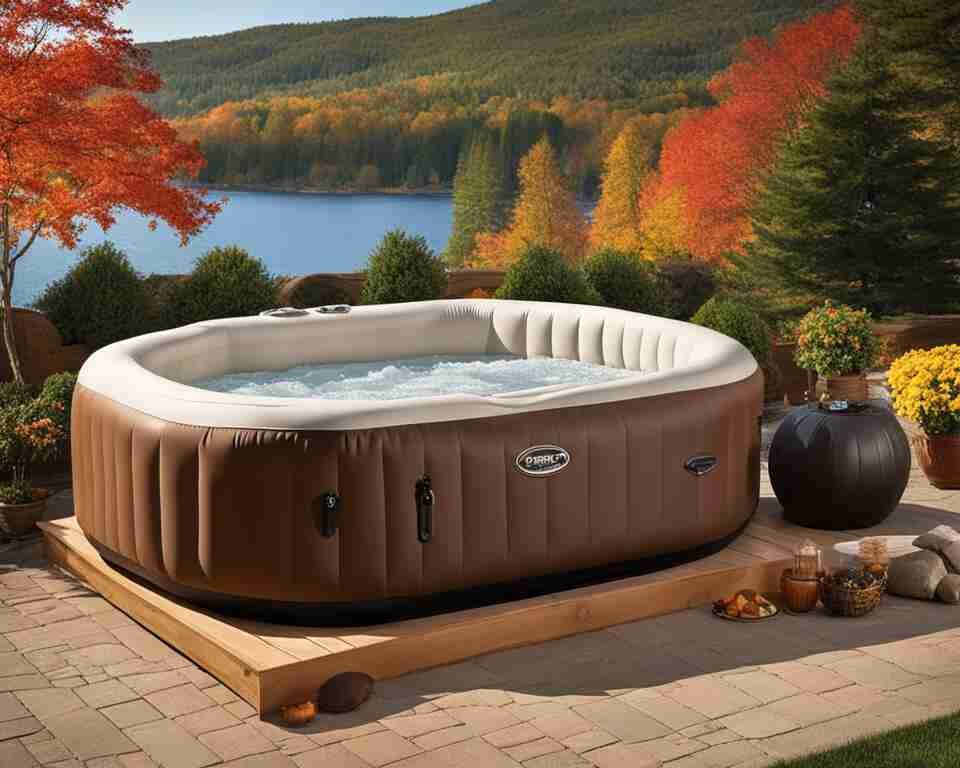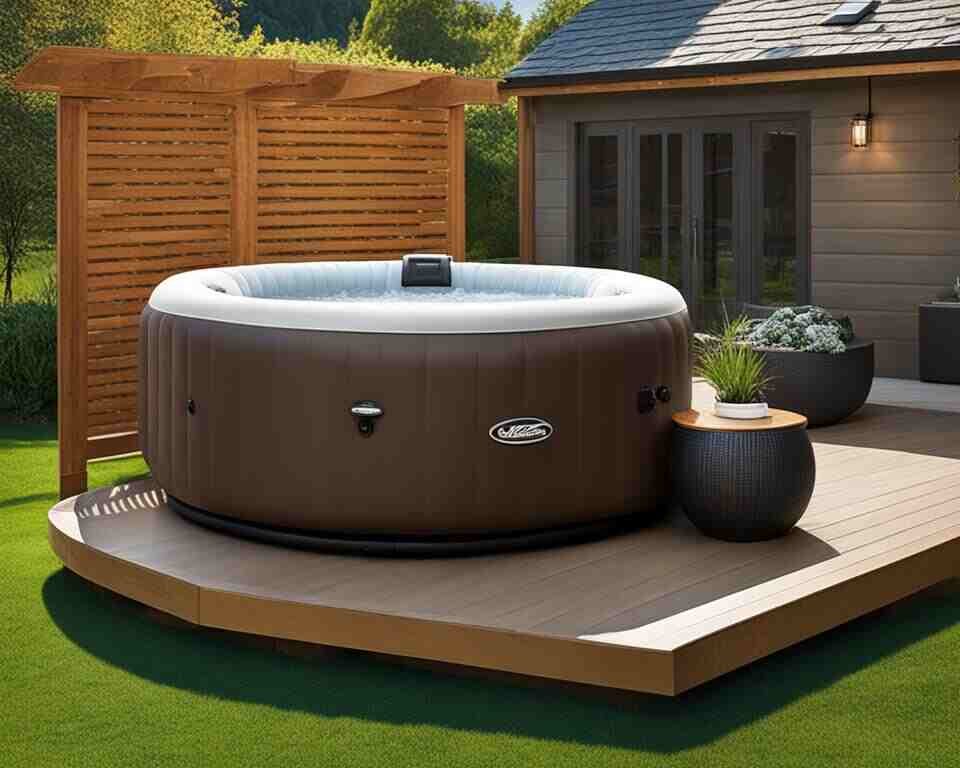When it comes to hot tubs, the debate between rigid foam and inflatable options is a common one. Both types have their own benefits and drawbacks, making it important to understand the key differences in order to make an informed decision.
In this article, I will compare rigid foam and inflatable hot tubs across various factors such as cost, portability, insulation, durability, build quality, energy efficiency, comfort, and long-term investment prospects.
By the end, you will have a clearer understanding of which type of hot tub best suits your needs and preferences.
Key Takeaways:
- Rigid foam and inflatable hot tubs have their own unique benefits and drawbacks
- Factors to consider include cost, portability, insulation, durability, build quality, energy efficiency, comfort, and long-term investment prospects
- Your needs, preferences, and budget should guide your choice between the two types of hot tubs

Understanding the Basics of Hot Tub Types
Before diving into the comparison between rigid foam and inflatable hot tubs, it’s important to understand the basics of each type. Rigid foam hot tubs are the traditional hard-shell design that is built to last and provides superior comfort and durability.
On the other hand, inflatable hot tubs are portable and more affordable, making them a popular choice for those who value convenience and budget-friendliness. By understanding the fundamental characteristics of these hot tub types, you can better evaluate their pros and cons.
Benefits and Drawbacks of Inflatable Hot Tubs
Cost and Affordability
Inflatable hot tubs offer significant cost advantages over rigid foam options. They are more affordable, making them a great choice for individuals on a budget. The lower cost of inflatable hot tubs allows more people to experience the luxurious relaxation and therapeutic benefits of hot tubs without breaking the bank. So, if you’re looking for a cost-effective option, an inflatable hot tub may be the perfect choice for you.
Portability and Convenience
One of the standout advantages of inflatable hot tubs is their high level of portability and convenience. Unlike rigid foam hot tubs, inflatable models can be easily transported and stored. Their lightweight design and compact size allow you to move them around your backyard or take them with you on camping trips or vacations. The convenience of being able to set up your hot tub anywhere you like offers a level of flexibility that is hard to match.
Insulation and Energy Efficiency
While inflatable hot tubs offer many benefits, it’s important to consider their insulation and energy efficiency. Due to the nature of their construction, inflatable models generally have less effective insulation compared to rigid foam hot tubs.
This can result in higher energy consumption and increased heating costs. However, advancements in technology have led to the development of inflatable hot tubs with improved insulation features, helping to mitigate this drawback to some extent.
Durability: A Question of Longevity
One aspect where inflatable hot tubs may fall short is in terms of durability and longevity. The inflatable materials used in these tubs can be prone to punctures and wear over time, which can lead to leaks and reduced lifespan.
However, proper care and maintenance can significantly prolong the life of an inflatable hot tub. If you are looking for a long-term investment, rigid foam hot tubs tend to offer better durability and longevity, but inflatable options can still provide years of enjoyment with proper care.

| Advantages of Inflatable Hot Tubs | Drawbacks of Inflatable Hot Tubs |
|---|---|
| Lower cost and affordability | Less effective insulation |
| High portability and convenience | Potential for punctures and leaks |
| Easy transportation and storage | Reduced durability |
| Shorter lifespan compared to rigid foam hot tubs |
Are Rigid Foam Hot Tubs Better Than Inflatable?
When it comes to choosing a hot tub, one of the key decisions is whether to opt for a rigid foam or an inflatable model. In this section, we will explore the various aspects where rigid foam hot tubs excel, making them a strong contender in the hot tub market.
Build Quality and Durability
Rigid foam hot tubs are known for their exceptional build quality and durability. Made with sturdy materials, these hot tubs are designed to withstand the test of time. The rigid structure provides stability, ensuring that the hot tub remains intact even with frequent use. This robust build quality gives users peace of mind, knowing that their investment is built to last.
Energy Efficiency: A Cost-Effective Choice
Energy efficiency is an important consideration when choosing a hot tub. Rigid foam hot tubs offer superior insulation properties compared to inflatable models. The thick foam walls trap heat inside, reducing energy consumption and costs. With better heat retention, rigid foam hot tubs are a cost-effective choice in the long run, saving you money on energy bills.
Comfort and Therapeutic Advantages
The comfort level provided by rigid foam hot tubs cannot be overstated. These hot tubs come with built-in seats that offer optimal support and relaxation. Additionally, the jets in rigid foam hot tubs are strategically placed to target specific areas of the body, providing therapeutic water massage. The combination of comfort and therapeutic advantages makes for a truly enjoyable hot tub experience.
Long-Term Investment Prospects
Investing in a rigid foam hot tub is not just about immediate gratification; it’s a long-term investment. The build quality, durability, and energy efficiency of these hot tubs contribute to their long-term value. They require minimal maintenance and are built to withstand years of use, ensuring that you can enjoy the benefits of your hot tub for many years to come. Moreover, the therapeutic advantages and overall quality of rigid foam hot tubs can increase the resale value of your property, further enhancing the long-term investment prospects.

Comparing the Costs: Upfront and Long-Term Considerations
When it comes to choosing between rigid foam and inflatable hot tubs, cost is a crucial factor to consider. Understanding the upfront and long-term expenses associated with each option can help you make an informed decision based on your budget and financial considerations.
In terms of upfront cost, inflatable hot tubs have a clear advantage. They are generally more affordable than their rigid foam counterparts, making them a popular choice for those on a tight budget. However, it’s important to note that the initial investment is just one piece of the puzzle.
While inflatable hot tubs may seem like a budget-friendly option at first, they can incur higher long-term expenses. One key concern is their energy inefficiency. Due to their design, inflatable hot tubs typically have poorer insulation, resulting in higher heating costs over time. This can significantly impact your monthly utility bills.
Additionally, the lifespan of inflatable hot tubs tends to be shorter compared to rigid foam hot tubs. The materials used in inflatable models are more prone to wear and tear, increasing the likelihood of repairs or the need for replacement sooner than anticipated. These additional costs should be taken into account when considering the long-term affordability of an inflatable hot tub.
On the other hand, rigid foam hot tubs require a higher initial investment, but they can offer cost savings in the long run. Their superior insulation properties and energy efficiency help to minimize ongoing heating costs. Furthermore, rigid foam hot tubs are built to last, providing a longer lifespan and reducing the need for costly repairs or replacements.
By comparing the costs between rigid foam and inflatable hot tubs, you can determine which option aligns better with your budget and financial goals. While inflatable hot tubs may be more cost-effective upfront, rigid foam hot tubs offer the potential for long-term savings and a higher return on investment.
| Cost Considerations | Rigid Foam Hot Tubs | Inflatable Hot Tubs |
|---|---|---|
| Upfront Cost | Higher initial investment | Lower initial cost |
| Long-Term Cost | Potential for cost savings due to energy efficiency and durability | Possible higher expenses due to energy inefficiency and shorter lifespan |
Making the Choice: Factors to Consider When Purchasing a Hot Tub
When deciding between rigid foam and inflatable hot tubs, there are several factors to consider. Assessing your space and portability needs is crucial to ensure that the chosen hot tub fits your lifestyle and location. Additionally, considering the maintenance and upkeep requirements of each type can help you determine the level of commitment you are willing to make.
Heat retention is another important factor to consider for a comfortable and energy-efficient hot tub experience. Finally, understanding whether you primarily seek leisure or therapeutic benefits from a hot tub can further guide your decision-making process.
Assessing Your Space and Portability Needs
Space and Portability: Consider the available space in your home or backyard. Rigid foam hot tubs are typically larger and require a fixed installation, while inflatable hot tubs offer more flexibility in terms of placement and are easily portable. If you have limited space or if you like to take your hot tub with you when you travel, an inflatable option may be more suitable.
Maintenance and Upkeep: Inflatable vs. Rigid Foam
Maintenance and Upkeep: Hot tub maintenance is an essential aspect of ownership. Inflatable hot tubs generally have simpler maintenance needs, such as regular cleaning and occasional filter replacement. Rigid foam hot tubs, on the other hand, may require more regular maintenance tasks, including water chemistry management and winterization. Consider the time and effort you are willing to invest in maintaining your hot tub before making a decision.
The Importance of Heat Retention in Hot Tub Selection
Heat Retention: Heat retention is crucial for a comfortable and energy-efficient hot tub experience. Rigid foam hot tubs typically have better insulation properties, which means they can retain heat more effectively, resulting in lower energy consumption and cost. If you prioritize heat retention and energy efficiency, a rigid foam hot tub may be the better choice.
Intended Use: Leisure vs. Therapeutic Benefits
Leisure vs. Therapeutic Benefits: Consider whether you primarily seek a hot tub for leisure or therapeutic purposes. Rigid foam hot tubs often come with built-in seats and a variety of jet configurations, offering a more customizable and therapeutic experience. Inflatable hot tubs, while still providing relaxation, may have fewer jet options and less tailored therapeutic functionality. Determine your desired hot tub experience and select the type that aligns with your intended use.

Conclusion
After carefully evaluating the differences between rigid foam and inflatable hot tubs, it is clear that there is no definitive answer to which type is better. The choice ultimately depends on individual preferences and specific needs. By considering factors such as cost, durability, energy efficiency, comfort, and long-term investment prospects, you can make an informed decision and select the hot tub that best suits your requirements.
Both rigid foam and inflatable hot tubs offer unique benefits and drawbacks. Rigid foam hot tubs are known for their superior build quality and durability, providing a long-lasting investment. They also offer enhanced energy efficiency and comfort, making them an excellent choice for those seeking therapeutic advantages. However, they do require a higher upfront cost.
Inflatable hot tubs, on the other hand, are more affordable and highly portable, making them a convenient option for those with limited space or the need for mobility. While they may lack some insulation and energy efficiency compared to rigid foam hot tubs, they still provide a relaxing and enjoyable experience at a lower price point.
In conclusion, when choosing between rigid foam and inflatable hot tubs, it is essential to consider your personal preferences, budget, available space, and desired features. By carefully weighing the pros and cons, you can make the best decision for your hot tub needs. Remember to prioritize factors such as cost-effectiveness, durability, comfort, and long-term investment potential to ensure you get the most out of your hot tub purchase.

